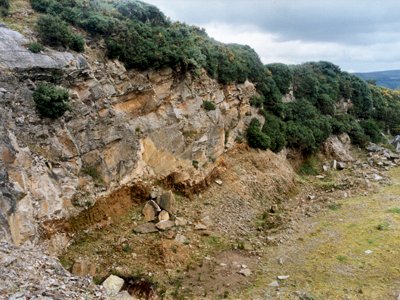Earth Science Conservation Review
| Kildoag Quarry | Londonderry |
| Site Type: | Quarry (working) |
| Site Status: | ESCR |
| Grid Reference: | C498085 |
| Google maps: | 54.92209,-7.2233 |
| Rocks | |
|---|---|
| Rock Age: | Precambrian (Dalradian) |
| Rock Name: | Claudy Formation, Southern Highlands Group |
| Rock Type: | Psammite, Quartz psammite |
| Interest | |
Summary of site:
The importance of this quarry lies in the exceptional outcrops of quartz-rich metamorphic rocks which belong to the Dalradian Supergroup of the Precambrian period. The Dalradian is divided into two groups, the Argyll Group at the base and the Southern Highland Group above. The Southern Highland Group is further subdivided into three formations. The rocks at Kildoag belong to the earliest of these three, the Claudy Formation.
In the quarry around 10 m of rock form the main working face. All the rocks are metamorphosed and the overwhelming rock type is an altered quartz sandstone weathering to a glowing orange-brown colour. The beds are thick (up to 1 m) and separated by altered muds and shales which are now silvery grey to dark green. The original sediments show some cyclicity, a repeated pattern of rock types, here consisting of several thick sandy beds followed by moderately thick altered shales. This basic cycle is repeated several times. All the beds tilt to the north west.
All the rocks show metamorphic structures, particularly a cleavage (a plane of splitting) slightly steeper than the bedding planes. It is believed to relate to a giant overfold, over 40 km wide, in the Sperrin Mountains. Combined with more minor metamorphic structures, the evidence suggests that the rocks in the quarry are the right way up i.e. not overturned.
The rocks formed some 600 million years ago in an ocean basin centred on the South Pole, then ice-free, close to land with a ready supply of quartz sand. These conditions prevailed for a considerable time and the entire thickness of the Claudy Formation is estimated to be between 2,000 and 4,000 m.
The whole formation (indeed all the Dalradian rocks) was metamorphosed during a time of continental collision about 465 million years ago. Although widespread, the metamorphism was of relatively low intensity.
The Claudy Formation is believed to be equivalent to the Dart Formation on the overturned south easterly limb of the massive Sperrins fold. The main difference between the two is attributed to their position in the sedimentary basin, the Dart rocks being further from the shore.
The site has some economic significance as a building stone resource, the altered sandstone dressing into a particularly attractive and durable building stone. The resurgence of interest in stone building may well renew interest here.
The rocks are well and cleanly exhibited in the quarry and the site is worthy of protection.
In the quarry around 10 m of rock form the main working face. All the rocks are metamorphosed and the overwhelming rock type is an altered quartz sandstone weathering to a glowing orange-brown colour. The beds are thick (up to 1 m) and separated by altered muds and shales which are now silvery grey to dark green. The original sediments show some cyclicity, a repeated pattern of rock types, here consisting of several thick sandy beds followed by moderately thick altered shales. This basic cycle is repeated several times. All the beds tilt to the north west.
All the rocks show metamorphic structures, particularly a cleavage (a plane of splitting) slightly steeper than the bedding planes. It is believed to relate to a giant overfold, over 40 km wide, in the Sperrin Mountains. Combined with more minor metamorphic structures, the evidence suggests that the rocks in the quarry are the right way up i.e. not overturned.
The rocks formed some 600 million years ago in an ocean basin centred on the South Pole, then ice-free, close to land with a ready supply of quartz sand. These conditions prevailed for a considerable time and the entire thickness of the Claudy Formation is estimated to be between 2,000 and 4,000 m.
The whole formation (indeed all the Dalradian rocks) was metamorphosed during a time of continental collision about 465 million years ago. Although widespread, the metamorphism was of relatively low intensity.
The Claudy Formation is believed to be equivalent to the Dart Formation on the overturned south easterly limb of the massive Sperrins fold. The main difference between the two is attributed to their position in the sedimentary basin, the Dart rocks being further from the shore.
The site has some economic significance as a building stone resource, the altered sandstone dressing into a particularly attractive and durable building stone. The resurgence of interest in stone building may well renew interest here.
The rocks are well and cleanly exhibited in the quarry and the site is worthy of protection.
| Enlander, I., Dempster, M. & Doughty, P., 2025. Kildoag Quarry, County Londonderry, site summary. [In] Earth Science Conservation Review. https://www.habitas.org.uk/escr/summary.php?item=148. Accessed on 2025-04-03 |
| Previous Site | Next Site |
